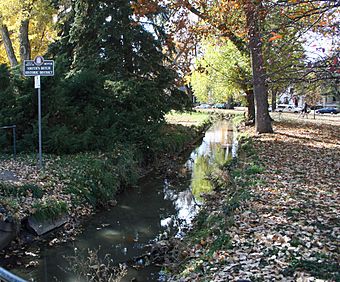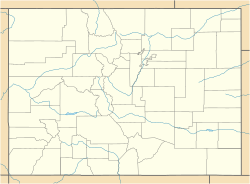Smith's Irrigation Ditch facts for kids
Quick facts for kids |
|
|
Smith's Irrigation Ditch
|
|

Smith's Ditch in Washington Park
|
|
| Location | Washington Park, Denver, Colorado |
|---|---|
| Area | less than one acre |
| Built | 1865 |
| Built by | John W. Smith |
| NRHP reference No. | 76000555 |
| Added to NRHP | October 8, 1976 |
Smith's Irrigation Ditch, also called the City Ditch, is a very old and important waterway in Denver, Colorado. It was Denver's first ever irrigation canal! You can still see parts of it today, especially in Washington Park. This historic ditch is so important that it's listed on the National Register of Historic Places. This means it's a special place recognized for its history.
Contents
Building the Ditch
How It Was Made
Work on Smith's Irrigation Ditch started a long time ago, in 1860. It took many years to build, finally finishing in 1867. When it was first dug, it was an open ditch, meaning it didn't have a special lining.
The bottom of the ditch was about 3 feet (about 1 meter) wide. The sides were steep, and the top was about 7 feet (about 2 meters) wide. Imagine how much work that was!
Hard Work and Tools
Building such a long ditch wasn't easy. Workers used horse-drawn plows to break up the ground. They also used scrapers, which are tools pulled by horses to move dirt. A lot of manual labor was involved too, with people digging by hand.
Where the Ditch Goes
Its Long Journey
Smith's Ditch starts near the Chatfield Dam. From there, it travels for about 15 miles (about 24 kilometers) through the town of Englewood. Englewood even uses some of this water for its town's water supply.
Water for Denver
When the ditch reaches Harvard Gulch, near S. Downing Street and East Harvard Avenue, the Denver Water Department takes over. From this point, the water now flows through an enclosed pipeline for about 8 miles (about 13 kilometers).
Open Channel in Washington Park
After its journey in the pipeline, the ditch becomes an open channel again when it reaches Washington Park. Here, you can see the water flowing freely. This water is super important for the park! It helps keep the many trees, beautiful flowers, and green grass healthy and growing.



